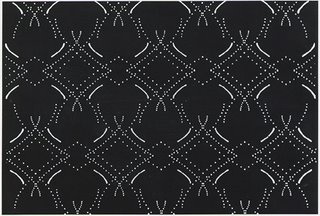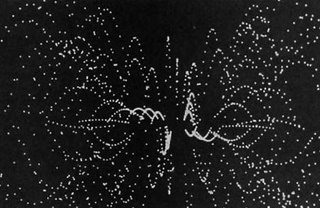by Gene Youngblood
Larry Cuba is one of the most important artists currently working in the tradition known variously as abstract, absolute or concrete animation. This is the approach to cinema (film and video) as a purely visual experience, an art form related more to painting and music than to drama or photography. Viking Eggeling, Hans Richter, Oskar Fischinger, Len Lye, Norman McLaren and the Whitney brothers are among the diverse group of painters, sculptors, architects, filmmakers and video and computer artists who have made distinguished contributions to this field over the last 73 years.
Insofar as it is understood as the visual equivalent of musical composition, abstract animation necessarily has an underlying mathematical structure; and since the computer is the supreme instrument of mathematical description, it's not surprising that computer artists have inherited the responsibility of advancing this tradition into new territory. Ironically, very few artists in the world today employ the digital computer exclusively to explore the possibilities of abstract animation as music's visual counterpart. John Whitney, Sr. is the most famous, and rightly so: he was the first to carry the tradition into the digital domain, and his book Digital Harmony is among the most rigorous (if also controversial) theoretical treatments of the subject. But for me Cuba's work is by far the more aesthetically satisfying. Indeed, if there is a Bach of abstract animation it is Larry Cuba.
Words like elegant, graceful, exhilarating or spectacular do not begin to articulate the evocative power of these sublime works characterized by cascading designs, startling shifts of perspective and the ineffable beauty of precise, mathematical structure. They are as close to music---particularly the mathematically transcendent music of Bach---as the moving-image arts will ever get.
Cuba has produced only four films in thirteen years. The best known are 3/78 (Objects and Transformations) (1978) and Two Space (1979). The imagery in both consists of white dots against a black field. In 3/78 sixteen "objects," each consisting of a hundred points of light, perform a series of precisely choreographed rhythmic transformations against a haunting, minimal soundtrack of the shakuhachi, the Japanese bamboo flute. Cuba described it as “an exercise in the visual perception of motion and musical structure." In Two Space, patterns resembling the tiles of Islamic temples are generated by performing a set of symmetry operations (translations, rotations, reflections, etc.) upon a basic figure or "tile." Twelve such patterns constructed from nine different animating figures are choreographed to produce illusions of figure-ground reversal and afterimages of color. This is set against 200 year old Javanese gamelan music. Both films have won numerous awards and have been exhibited at festivals around the world . Calculated Movements, Cuba's first work in six years, premiered in July at the San Francisco Museum of Modern Art and was also included in the film and video show of SIGGRAPH '85, the international computer graphics conference. It is a magnificent work, destined to join 3/78 and Two Space as a classic of abstract animation. It represents a formal departure from its predecessors. Whereas they were produced on expensive vector graphic equipment at institutional facilities, using a mainframe and minicomputer respectively, Calculated Movements was produced at Cuba's studio in Santa Cruz on the Datamax UV-1 personal computer with Tom DeFanti's Zgrass graphics language. This is a raster-graphic system that allowed Cuba to work for the first time with solid areas and "volumes" rather than just dots of light. The result, both in design and dynamism, is strongly reminiscent of the films of Oskar Fischinger.
Computer animation is neither film nor video---those are simply media through which a computer's output can be stored, distributed and displayed. Previously Cuba released his work only on film, but Calculated Movements is available on both film and video. We talked about the theory and practice of abstract animation, about the computer as an instrument of that practice, and about the production of Calculated Movements.



Interview from Video and the Arts Magazine, Winter 1986: www.well.com/~cuba/VideoArt.html
(Images: Two Space, 1979; Calculated Movements, 1985; 3/78, 1978)

Hi Jennifer,
ResponderEliminarLarry Cuba only made four films. Two af them are available in emule Calculated Movements and Two Spaces, i really recommend this last one.
I think i should change the images, i don't like them at all... maybe one of this days.
Thanks,
Albert
Hello Jennifer and Albert,
ResponderEliminarThank you for your interest in my work.
Albert, I can get you some better looking stills from the films.
Jennifer, I can notify you of upcoming screenings.
Please write to me at this address:
p13ut2402@sneakemail.com
Thanks.
See ya,
Larry Cuba